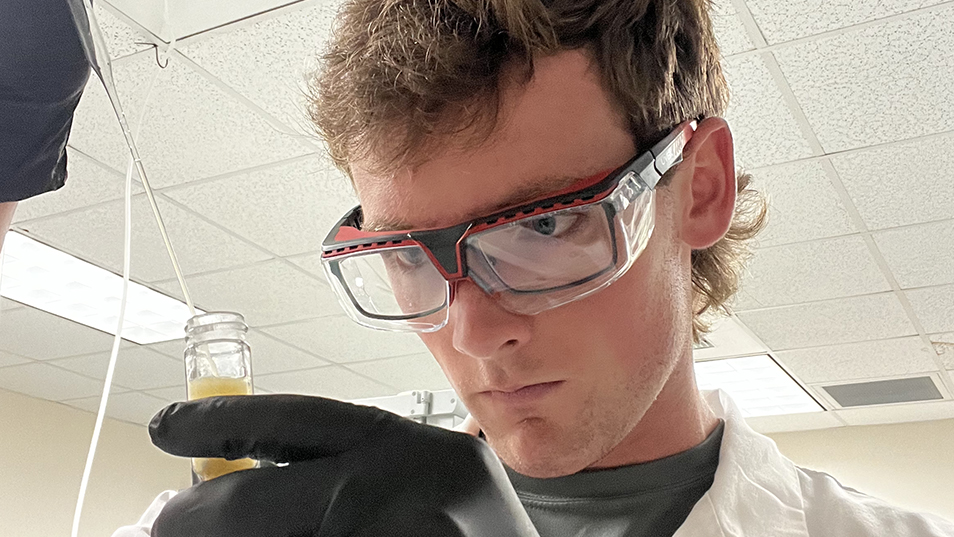Contact us
401 W. Kennedy Blvd.
Tampa, FL 33606-13490
(813) 253-3333
Brian Veit '25 wants to bring back biodiesel.

Brian Veit ’25, a chemistry major, recently pursued a hypothesis that a mentor, Assistant Professor of Chemistry John Struss, had long abandoned. The result is a new, safer kind of biodiesel with ethanol and ethyl acetate, which can be made quickly and more profitably than the industry standard. Photo courtesy of Veit
Brian Veit wants to bring back biodiesel.
Veit ’25, a chemistry major, recently pursued a hypothesis that a mentor, Assistant Professor of Chemistry John Struss, had long abandoned. The result is a new, safer kind of biodiesel made from ethanol and ethyl acetate, which can be made quickly and more profitably than the industry standard.
Veit says biodiesel is “America’s forgotten golden child.” He explained that since the early 2000s, the U.S. has required a percentage of biodiesel to be mixed into diesel fuel to reduce sulfur emissions that cause acid rain.
The problem is that engines need something called lubricity to make them last longer. Sulfur and diesel provide that lubricity, so chemists needed a workaround.
They discovered methanol, a catalyst for biodiesel, solved the issue. It was green energy — on paper.
In practice, it was different. The methanol-biodiesel processing was slow and dangerous.
“If you get oxygen accidentally going into that reactor, they just straight blow up,” said Veit.
Plus, making methanol-biodiesel is time-consuming, eating into profits. The fuel congeals if the temperature gets too low. Some states ban methanol-biodiesel altogether or restrict it in the winter.
Struss came up with a possible solution in the 2010s, but he never got a chance to test what he calls his “pet project”. Then, biodiesel looked all but forgotten when electric cars hit the market, and industry research and development efforts and attention turned away from biodiesel.
Problems remain, though. Veit says electric vehicle batteries are “energy dense” and not practical for long hauls.
”You get 10 times more energy in (a) square foot (of a biodiesel fuel tank) than you would in a square foot of a battery,” Veit explained.
“I find that very unfortunate. I see (biodiesel) as the solution to our long-haul trucking, our long-haul trains and ships; all of those are going to have to be running on petroleum fuel for God knows how long.”
Veit learned about Struss’s hypothesis from the 2010s, dropped after a long sabbatical and in favor of new projects, and he was intrigued.
Veit reached out to Struss, and the pair decided to take on biodiesel together.
“I have to admit, I have never had a student as enthusiastic as Brian,” Struss said.
“He’s latched onto this project like a terrier to a soup bone!”
Veit tested the ethanol and ethyl acetate process in the lab. They kept it simple, from the chemical compounds to the equipment. The ethyl acetate was made by combining ethanol and acetic acid, which is another word for vinegar. The catalyst and the reactants were in two vials connected by a tube. Veit said it was like blowing air into a straw.
“They’re called cannulas, the straws, and I would have another bleeder valve. But instead of ripping it out, I just put my finger on it. Just putting my finger on it would pressurize it enough to shoot it out like a mini beer tap,” Veit said.
After, they recorded how long the reaction took.
“It was so fast, it ran to the point where we can't even get data of kinetics,” Veit said.
They made 85% pure biodiesel in just 15 seconds.
"Suffering from success is, quite literally, what we’re running into,” Veit said.
Now, this project could be the catalyst needed for Veit’s future and the biodiesel industry. He will apply to graduate school with a grant from the National Science Foundation Graduate Research Fellowship Program.
Struss is “absolutely certain” that Veit will fit in with any graduate research group.
Veit’s vision is to bring the solution out of academia and to a biodiesel facility one day.
More UT News